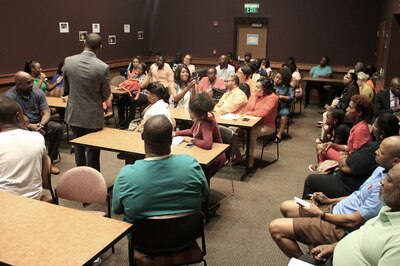For Felecia Bean-Barnes, curriculum is key.
A parent and president of Westwood High School’s PTA, she’s observed that some Shelby County schools offer advanced placement curriculum or courses in Japanese, for instance, while others don’t.
“We don’t have all the classes at our school that we wish she had,” Bean-Barnes told district leaders at a recent community meeting seeking input from Memphians on what makes a high-quality school.

Another parent at the Whitehaven-area meeting quickly chimed in. “We need a foreign language program that starts in elementary school to get these kids college-ready. … We’re trying to do 12 years of school in four years. We’ve got to get on the ball.”
The comments were gleaned during nine community meetings held by Shelby County Schools in the last week, capped by three gatherings Monday night. District staff members facilitated the sessions and documented feedback to gauge community priorities as leaders prepare to downsize the school system amid years of declining enrollment.
“We have limited resources to work with, so we have to start thinking differently about how we maximize our resources, so all our students have equal opportunities,” Superintendent Dorsey Hopson said in a videotaped message played at the start of each meeting. “That could mean closing, merging or transforming schools in order to create new high-quality options.”
A yearlong facilities study, scheduled for release this fall, will help guide the hard decisions that policymakers say ultimately must hinge on how to improve academic performance. A district spokeswoman did not respond to questions last week about how the community input eventually will intersect with that data to inform decisions about shuttering schools. But facilitators and school board members assured participants that their feedback is critical to the process. (See Chalkbeat’s report on 25 schools at risk.)
Some meetings drew more than 60 people, others just a few handfuls, as many participants cited engaged parents as one attribute of a high-quality school. One teacher suggested reinstituting family resource centers in all schools to provide resources and training for parents to offset challenges related to a mostly impoverished student population.
Participants defined high-quality schools based on up-to-date technology, small class sizes, retention of high-quality teachers, a climate of safety, STEM curriculum, and the availability of after-school tutoring and field trips, among other things.
Meanwhile, facilitators indicated that the district will measure the quality of schools based on three factors: student achievement, student growth and school climate.
Here are some comments shared at various community meetings:
- “Every school needs a high-quality administrator, one that’s aware of the conditions of the school, knows the neighborhood and has a passion for what they’re doing. It starts with leadership.” —Terri Stephens, sixth-grade world history teacher at Havenview Middle School
- “I look at test scores because I know (my daughter) needs a challenge. —Amber Currin, parent of a second-grader who participates in CLUE at Grahamwood Elementary School
- “All schools should have optional programs. We shouldn’t create inferior schools to have better schools. They should be even across the board.” —Claudette Boyd, whose grandchild attends Melrose High School
- “Everything starts at the top of the school with a strong administration.” — Leonard Smith, retired educator with Memphis City Schools
- “You have to have strong teachers. You need good leadership. Quality of the teachers is a must.” — Kayla Smith, parent of students at Oakhaven middle and high schools
- “We need stability in our school system. Many of our children come from an unstable home environment and then we’re sending them to an unstable school environment where we’re not sure whether those schools will stay open. We tell them “relax and learn,” but someday we’re going to learn that school flight is generating panic and fear.” —Vernall Smith, a graduate of Mitchell High School and grandfather of three Mitchell students
The district has invited stakeholders to share additional feedback online.
Chalkbeat reporters Laura Faith Kebede, Caroline Bauman and Grace Tatter contributed to this report.

